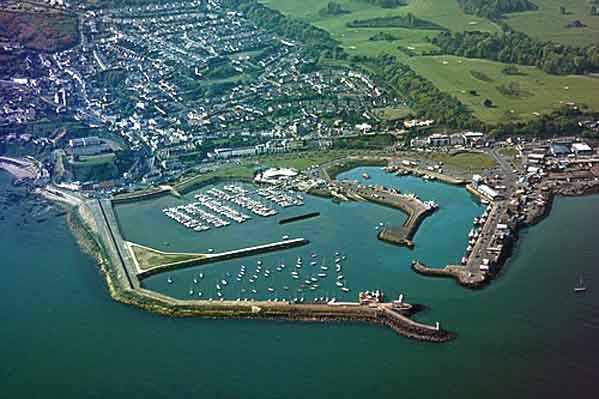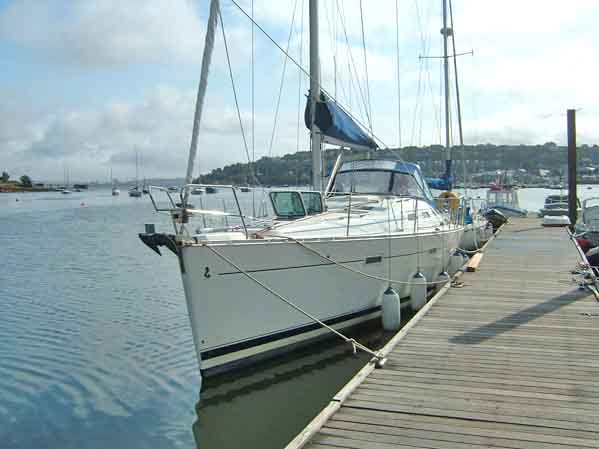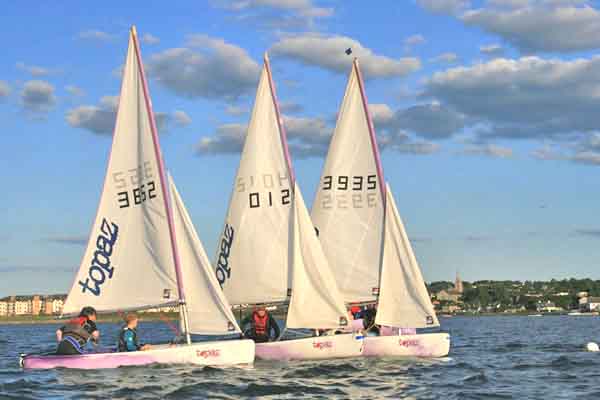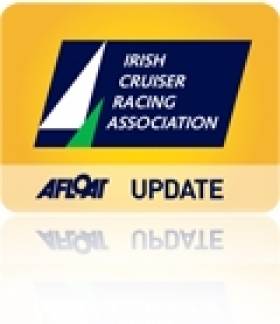Displaying items by tag: Dublin
Perfect Conditions on Day Two of ICRA Nationals
Blue skies coloured Dublin Bay again yesterday with a sea breeze of 12 knots providing perfect sailing conditions for the ICRA Nationals, writes Claire Bateman. The results illustrate the closeness of the competition in most divisions. Anthony O’Leary in Antix is leading IRC 0 after five races and indeed had the unusual situation today of having a tied result with Dave Dwyer’s Marinerscove.ie on corrected time each receiving 1.5 points in Race four. This is keeping it very much in the O’Leary family as it is Anthony’s son Nicholas is helming Mariners cove. Antix is very much the dominant force in Class zero, discarding a fifth after yesterday's racing to leave her with four wins on the scorecard.
ICRA members will be interested to know that Mariners had a better day scoring a total of 4.5 from the three races and as the defending champion is now a mere three points adrift of the leader. It is great to see Peter Rutter’s Quokka 8 competing and he is now lying third on 17 points.
In Class One IRC the O’Higgins Rockabill V appears to be walking away with the series having scored three wins and two seconds leaving him with seven points. Currently following on Rockabill’s heels, is a plethora of J109s led by J.Maybury’s Joker 2 followed by Jalapeno and Jelly Baby. However, should there be a discard tomorrow Jelly Baby could come up the leader board and it is all to play for here.
In Class Two IRC the pre race favourite, Kinetic, the Colwell/Murphy well sailed Corby 25 and defending title holder, has built up a good lead and is currently on 12 points followed by Denis Coleman’s Corby 25 Thunderbird from Cork with Anthony Gore Grimes in the X302 DUX just one point adrift. Things are very tight with the top two boats in Class Three IRC with just one point separating the current leader the O’Brien, Kenefick and Kenefick, Tiger, from the defending title hoilder Flor O’Driscoll in his J24 Hard on Port.
Currently lying third is Supernova and it most def initely is all to play for in this class.
In the Non Spinnaker Division Five IRC four races have been sailed and they have already received a discard. Counting the discard and leading on 4 points is Tsumnai, one point ahead of Orna followed by Lula Belle on 7 points.
In the Non Spinnaker Division 6, again with one discard applied, the Howth Yacht Club Dehler 34 Voyager is on four points, two points ahead of fellow HYC yacht Brazen Hussy, and a Welsh raider from Pwllheli SC, Mojito, who is on equal points with Brazen Hussy.
In Class 0 ECHO Marinerscove.ie continues to hold her lead followed by Tiamat and Antix respectively. In Class One ECH0 Rockabill V leads Joker 2 with Donal O’Leary’s D- ‐Tox in third position. In Class Two ECHO Kinetic leads Thunderbird Page 2 followed by Indigo who is on equal points with Thunderbird. Class Three ECHO has very tight results to date at the top with only one point separating the leading three boats.
The current leader is Jibberish on 33 points, followed by Tiger and Supernova both on 34 points. However, it is Tiger has the more consistent results which could stand to her in the case of a discard. Class Five ECHO Adelie is on 7 points, Lula Belle also has 7 points and the Sigma 38 Persistance is just one point adrift on 8 points. Class 6 ECHO is currently led by Voyager on 5 points followed by Brazen Hussy on 7 points and Mojito on 8 points.
A lot at stake for today in many classes.
Award for East Wall Sailing Group
East Wall Sailing Group was honoured with a Lord Mayor's Award today for its considerablye contribution to Dublin life. The group introduced 5,000 people to sailing and watersports from its sailing centre off Alfie Byrne Road last year, and has developed a range of new programmes through its new website www.eastwallsailing.com.
Since its inauguration in 1989 these awards honour individuals and groups who have made a special contribution to Dublin and its citizens. The awards are an annual event and are Dublin City’s way of saying ‘thank you’ to people who make a difference.
“It is an honour for me to present the individuals and groups here today with an Award. Their commitment, dedication and tireless efforts to their causes and their zest and love of life, have without doubt, enriched and enhanced our City. Tonight is my way of thanking the recipients on behalf of myself and the people of Dublin for their remarkable contribution to our society. I congratulate them on their achievements and wish them all the best for their future endeavours” said the Lord Mayor of Dublin, Councillor Emer Costello.
The East Wall Water Sports Group is a voluntary organisation based in East Wall Water Sports Centre on Alfie Byrne Road, Dublin 3. It introduces children and young people to rowing, sailing and kayaking. The group receives its award for encouraging thousands of young people to foster a love of the water and water sports from across Dublin city and in acknowledgement of Joe Teeling’s founding vision. Paul Dolan was there to receive the award on their behalf.
Howth Harbour
Howth Harbour

A picturesque fishing village nestled on the rugged peninsula that forms the north side of Dublin Bay, Howth is one of Ireland’s many hidden treasures. That is not to say that the village doesn’t receive its fair share of visitors. Far from it. Howth is a favourite holiday destination and benefits especially from its popularity amongst yachtsmen and pleasure boaters. Indeed Howth Yacht Club dates back to 1895 and with around 2,000 members it is by far the largest in the country and enjoys a busy programme of racing, regattas and voyaging. The marina and club complex combine state of the art with old and traditional with standards of services superb across the board. As you would expect from such a large club, berths are plentiful and marine services top notch.
Away from the harbour itself there is much to recommend Howth. Historians will love the ruined abbey, nearby Baily Lighthouse and 15th century castle. You can take a bracing stroll along the piers, sight-see aboard an open top tram, watch seals and dolphins in the waters along the shore and take in breathtaking views from cliff top walks. Of course, Howth’s working fishing port means that fish and seafood lovers are absolutely spoilt when it comes to dining out and the pub scene is second only to Dublin itself, if a little more relaxing.
Howth is a lovely place from which to discover Ireland. You can blow away the cobwebs and kick back and explore the magnificent coastline at your leisure knowing you will be returning after each trip to one of the friendliest places on earth. And that’s the truth.
Marine Services in Howth – click here
Pilot Notes for Howth – click here
Marinas in Howth – click here
Accommodation in Howth – click here
Emergency
Fire/Ambulance/Police: 999/112
Customs: 874 6571
Harbour Master: 83 222 52
Lifeboat: 8323 524
Beaumont Hospital: 83 777 55
Tourist Information – Fingal Tourist Information Office +353 1839 6955
Air Travel
Aer Lingus: 705 3333
British Midland: 283 8833
RyanAir Flight Information: 1550 200200
CityJet: 844 5566
Car Ferries
Stena Line: 204 7777
Irish Ferries: 66 10 511
Rail Transport – Iarnrod Eireann (Irish Rail): 83 66 222
Howth Harbour Harbour Master's Office – Captain Raja Maitra, tel +353 (0) 1 83 222 52 or mobile 086 3814926. fax +353 (0) 1 832 6948 (Office situated Northern End of Auction Hall)
South Coast Garda Sailing Club

South Coast Garda Sailing Club
The Garda Siochana (Irish Police Force), Sailing Club was formed in October 1993 to promote sailing and all its benefits among members of the Force.
The Force now has two clubs – one on the South Coast and another on the East Coast, based in Dublin.
Membership of SCGSC is open to Garda and non-Garda members. If you would like to learn more about what we do please contact us.
SCGSC is the proud owner s of Explorer, a Beneteau 393, pictured above. SCGSC has previously owned a Westerly Konsort and a Jeanneau SunFizz.
The 2005 cruising programme included a number of cruises on the South West Coast and two aborted cruises to the Isles of Scilly off Cornwall. Even the foolhardy occasionally stay in port in bad weather.
In the racing front the club has competed in the Round Ireland and Cork Week races. Already in 2005 the club claims a 3rd place in the Cobh Regatta and third overall in the Cobh Sailing Club September League. We also achieved a notable 6th place in the Royal Cork Yacht Club Autumn League White Fleet. Well done everybody concerned.
In racing in 2006 the Club placed 3rd in White Fleet in the annual Blackrock Race, we have also competed in several of the Leagues hosted by Cobh Sailing Club during the summer with notable results.
We would welcome contact from other police force sailing clubs internationally.
Cruise bookings: [email protected]
(The above information and image courtesy of the South Coast Garda Sailing Club)
South Coast Garda Sailing Club, c/o Patrick Allen, Anglesea Street Garda Station, Cork. Tel: 087 278 6794, email: [email protected]
Have we got your club details? Click here to get involved
Buccaneer Powerboat Club
Buccaneer Powerboat Club
Buccaneer Powerboat Club, c/o Stephen Taylor, Albatross, Kinsealy Lane, Malahide, Co. Dublin. Tel: 087 239 3054, email: [email protected]
Have we got your club details? Click here to get involved
Graphic Design and Printing
Graphic Design and Printing Service
Don't miss out on promoting your business.
Afloat magazine serves as the voice of the marine industry but we offer a design, typesetting, and website printing service too.
From simple stationery items and logos to complex website design and full colour brochures, we offer special discounts to firms in the marine industry.
Please call for a quotation. No job too small. Tel: 01 284 6161 or 01 2020 374.
Malahide Yacht Club
 Dinghies at the Evening Topaz Sailing. Photo: Brian McDowell
Dinghies at the Evening Topaz Sailing. Photo: Brian McDowell
Malahide’s Three Clubhouses…
1 The Three Day Wonder!
Although the club was founded in 1958 it did not have a clubhouse until 1959.
Despite planning the club's first Whitsun Open Meeting (on the Broadmeadows) the enthusiastic early members found time to acquire and erect a de-mountable wooden chalet that had been purchased from Barney Herron Prefab Homes in Leixlip. It cost £300.
They started assembling the new clubhouse on a site on the 'Band Gardens' – more or less our current St. James's Terrace site, which the Commodore, Lord Talbot had made available to the club. Work commenced on an April Monday and by Wednesday the roof was in position.
The building served the Lower Estuary sailors well and was used as a starters retreat when Mermaid races were started and finished at a line from the flagpole to a mark off Malahide Point. The building was removed in 1979 to make way for a more substantial premises.
2 The 2nd Clubhouse
In 1962 a site was acquired at Cave's Marsh on the Broadmeadows from the local farmer, Mr Cave. A clubhouse was erected and a dinghy pen fenced off. Starting as a builders hut, it grew over the years then suffered severe fire damage, was re-built, then extended to the solid structure of to-day. See the illustration at the head of this page.
3 Back to the Lower Estuary – The 3rd Clubhouse
The club celebrated its 21st birthday in 1979 and was thriving with high levels of dinghy sailing activity on the Broadmeadows and a growing fleet of small cruiser/racers on the lower estuary.
It was agreed that a more elaborate clubhouse was needed at St. James's Terrace and so a local architect, Mr. Brendan Canning, was engaged to draw up plans. A contract was signed with O'Rourke Builders Ltd. and with the help of bank finance and interest free loans from members a £60,000 clubhouse was constructed. The new facility was officially opened on Friday 30th May, 1980.
In that year the club officers were:
President: Capt. J. C. Kelly-Rogers
Vice President: Len E. Mills
Commodore: Peter Killen
Vice Commodore: Gerry Newman
Rear Commodore: Arthur Slye
Hon. Sec.: C. W. Woodman
Hon. Treasurer: Pat O'Keeffe
Hon. Sailing Sec.: Ashley Cross
Junior Affairs: Christy Sheridan
Committee Members: John Banim, George Long, George McIlhagga, John McInerney, Tom Mythen and Jim Twomey.
Trustees: M.J. Byrne, R.S. Dix, and C.W. Woodman.
In 1980 the membership stood at 99 Family, 70 Ordinary, 35 Cadet, 10 Associate and 11 Life Members
4 And our latest
For almost a decade the Club had hopes of moving from St. James's Terrace to the marina area as it was always felt that it would be in our interests to be close to the boats moored in the marina. However, we were unable to reach an accord with any of the various parties involved over the years with the marina development project. Consequently, a general meeting of members on 17 October, 2001 authorised the Executive Committee proceed with a major refurbishment and extension of the existing premises at St. James's Terrace. The club had accumulated a substantial cash balance in recent years and the balance of expenditure was to be financed by bank borrowings and a small increase in subscriptions over the following three years.
After much drawing and redrawing of plans agreement was reached with Ray Mac Donnell Architects on extending to the East at a higher floor level to provide a large lounge with panoramic windows, extending to the South to allow for a new bar, keg room and kitchen and a complete makeover of the toilet and shower facilities. Lissadell Construction Ltd. were awarded the contract. Eventually, on 22 June 2003 the magnificent new facility was officially opened and is now being much enjoyed and appreciated by members and friends. The works cost just under €600,000 inclusive of VAT.
The Ripple
 The Ripple, a 12 ton cutter, was built in Belfast in 1862 for G. Brett by D. Fulton, a building contractor who also built yachts. Fulton was a leading member of the Royal Ulster YC and also a member of the Clyde, Mersey, Western and Prince Alfred yacht clubs.
The Ripple, a 12 ton cutter, was built in Belfast in 1862 for G. Brett by D. Fulton, a building contractor who also built yachts. Fulton was a leading member of the Royal Ulster YC and also a member of the Clyde, Mersey, Western and Prince Alfred yacht clubs.
At Carrickfergus Regatta in 1866 there was a 12 ton cutter Ripple owned by D. Boyd of Royal Mersey Yacht Club.
The vessel was purchased by George Murney, also a Royal Mersey member, probably in 1868 because in that year he commissioned the above picture by W. Abernethy which is now in the possession of the Royal Ulster YC. At this time he also owned an 8 ton cutter Lily. Murney was an original member of the RUYC, number 13 on their list of members and their first treasurer in 1867. He remained a member until the late 1880s. His brother Dr. D. Murney was number 6 on the Royal Ulster original members list and was Rear Commodore from 1875 until 1883. George was a keen yachtsman, not only in Belfast Lough as he and Ripple appeared in Carlingford regattas in 1872, 1877 and 1878, at Malahide in 1870, 1872–1875 and the Royal Irish in 1887. Racing yachts in those days did not carry sail numbers but flew an owner’s distinctive flag at the masthead, blue or red with a white lion rampant in the case of the Ripple as shown on the painting above.
Sailing at Broadmeadows
Malahide Yacht Club has a long tradition of dinghy sailing and we’re very proud of the achievements of our sailors over the years.
The club was established in 1958, initially concentrating on dinghy sailing in the Broadmeadows estuary. The fleet comprised mainly Herons for the juniors and Enterprises, with their distinctive blue sails, for the rest. Later Optimists became very popular for the 8-14 year olds. Very large fleets of the latter two classes developed and racing was to a high standard with the club producing Olympic representatives, Irish and British national champions and many others representing Ireland internationally. With the growth of other types of sailing, especially Cruiser Class III, dinghy sailing went into a decline, mirroring a national trend. However, there has been a tremendous resurgence locally with the introduction of the Topaz class and the fleet has gone from scratch to over fifty boats in the course of the last few years with growth continuing apace. Hand-in-hand with this activity has gone a major refurbishment of the shore side facilities at Broadmeadows.
We have a busy club race calendar with races every Thursday and Saturday during the season.
Other events, such as away events where we take some of our fleet to visit other clubs are generally organised by the Dinghy committee and posted on the website.
If you’re not a 'racer' and want to sail for fun make contact as we will also be arranging fun sailing events.
If you’ve never sailed and dinghy before and would like to try, we have club boats that can be rented for a modest fee so members can experience the excitement of dinghy sailing without having their own boat.
Evening Dinghy Racing – On Thursday evenings during season with first gun at 19.30 hrs.
Saturday racing on Broadmeadows – Racing for Lasers, Topaz, Mirrors, Optimists and sundry boats on most Saturdays throughout the season with First Gun at 15.00 hrs.
Dinghy sail training – Details on 'Courses and Tuition' page.
Training courses for Juniors – As in previous years, MYC is running its ever-popular summer training courses for juniors down in the Broadmeadows. ISA Levels 1, 2, 3 and 4 (Racing) courses will run concurrently. The first set of courses begins on Monday 3rd July and lasts for 3 weeks and the second on Monday 24th July. Full details and application form on 'Junior Courses' page.
2008-9 Officers & Committee of Malahide Yacht Club and Contacts
Commodore – Colm Fitzpatrick – 086 819 7584
Vice Commodore – Martin Clancy – 087 252 8559
Rear Commodore – Bob Sugrue – 086 804 8048
Hon. Secretary – Eddie Magee – 087 259 1418
Hon. Treasurer – Andy Deegan – 083 303 6731
Sailing Development – Brian McDowell – 087 232 7745
Membership – Deirdre Moore-Somers – 086 196 8553
Cruiser Racing – Brian Stewart – 087 329 8598
Cruising – Dave Farrell– 086 255 7120
Dinghy Sailing – Peter Cunning – 086 805 1783
Junior Affairs – Chris Shackleton – 086 820 6374
Bar – Irene Devitt – 087 699 5855
Clubhouse & Grounds – Michael McCabe – 087 245 2637
MYC 50th – Rose Michael – 087 255 2726
Dinghy Section – Optimist class Sec: Fran Thompson – [email protected]
Topaz class: Diarmuid Marron – [email protected]
Laser class Sec: Garrett Donnelly – [email protected]
Cruiser Section – Cruising: Dave Farrell – As above
Racing: Lee Douglas – As above
Membership Secretary: Deirdre Moore-Somers – As above
Clubhouse: Steward - Pat O'Keeffe – 845 3372/087 243 0646 (St. James's Terrace)
(The above information and image courtesy of Malahide Yacht Club
Malahide Yacht Club, Sea Road, Malahide, Co. Dublin. Get directions






























































